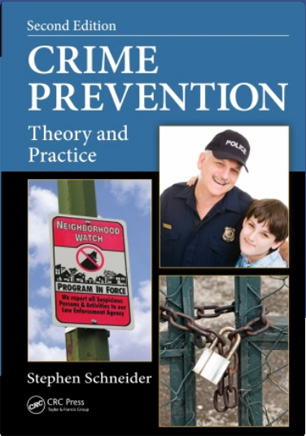Author: Stephen Schneider
ISBN No:
Review date: 25/04/2024
No of pages: 532
Publisher: CRC Press
Publisher URL:
https://www.routledge.com/Crime-Prevention-Theory-and-Practice-Second-Edition/Schneider/p/book/9780367738679
Year of publication: 07/12/2020
Brief:
Boot camps, electronic tag monitoring, life skills classes – there’s no lack of ideas and effort to prevent crime. Is it working, and if not, is that because it’s not done enough? Dive into the second edition of Stephen Schneider’s textbook, for ideas and answers.
The author is a Canadian academic criminologist, who’s also written about organised crime in Canada. Much of the case studies and other material comes from North America – though it’s striking how what works sounds familiar to the UK reader, and some European and Australian work is quoted.
Practical security manager readers may want to skip to the last three of the ten chapters, about crime prevention projects. While the subject and Schneider’s book is all about theory and its application in neighbourhoods, it’s notable that Schneider sees success as ‘characterised by strong, motivational leaders’. To do crime prevention, you have to involve and win over people, whether a community or (let’s say, in a car park or business park example) site users.
Early on the author writes of ‘crime prevention versus the criminal justice system’ (CJS), recalling that the field of crime prevention emerged in the 1960s, as an alternative to the CJS – ‘the traditional cops, courts and corrections [prisons] approach’, which did not seem to stem rising crime, as it did not rehabilitate offenders, nor bring them to justice in the first place. The case for crime prevention is not only that the CJS costs so much, it doesn’t address non-crime, such as ‘fear, disorder and public incivilities’.
The book takes us through the theory – or put another way, the evidence for crime prevention as a method that works. Some of the theory has entered the language ‘hot spots’ of crime, the ‘broken windows theory’ about repairing vandalism and graffiti, to counter any ‘perception among potential offenders that their transgressions will be tolerated’. Broken windows is also picked up in a chapter on policing, which sets out the ‘problem-oriented’ approach to recurring crimes.
We are then taken through CPSD (crime prevention through social development), notably work with at-risk children; and young adults. As the author points out; what if parents don’t welcome such ‘interventions’? And does giving children sports, after-school clubs, home visits and counselling – rather a grey area, between social policy generally and criminal justice – actually make a difference? If so, how do you measure that? Measuring, as in security management against criminals, physical or cyber, is the bugbear here – how to measure something that hasn’t happened, a child turned away from delinquency? The author also acknowledges that – reasonably enough – such work lacks evaluation; presumably the urge is to do good rather than take a clipboard to it.
Arguably more relevant to the security manager reader will be ‘labour market approaches to recidivism prevention’; as lack of a job is a ‘significant risk factor for re-offending’, especially for those leaving prison. Also covered are ‘community-based alternatives’ to prison, such as restorative justice, if a prison term may do more harm than good (to the offender, who may have a drug addiction or mental health problem) and to society (paying for the prison, when really the victim of crime may simply want healing, and that the offender does not re-offend and harm others). Here, studies suggest that restorative justice works better in cases of violent crime; yet much restorative justice has been done with so-called lesser crimes, such as theft against shops, implicitly creating a ranking of crimes, whereby more serious crime is reserved for the criminal courts.
As Schneider goes on to discuss, at issue here are two approaches to preventing crime, punitive and deterrence. The book in places could do with less jargony language – such as ‘parental responsibilization’ (page 232). On the whole, though, this substantial book is clear; and balanced, and well laid out. Schneider makes above all a case for ‘evidence-based, social problem-solving approaches’ to what is after all a ‘complex problem’ – people.
More on the author at https://stephenschneider.ca/.










